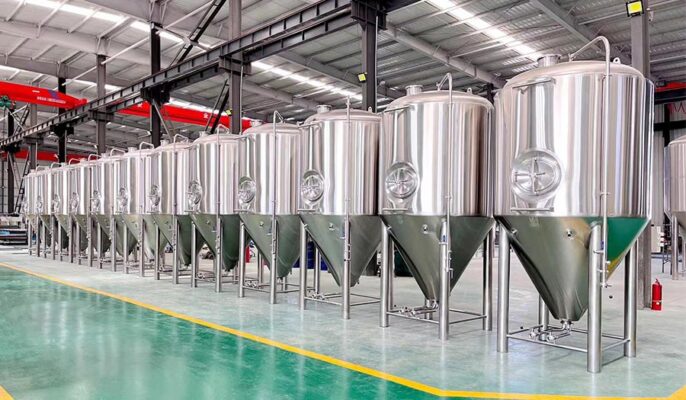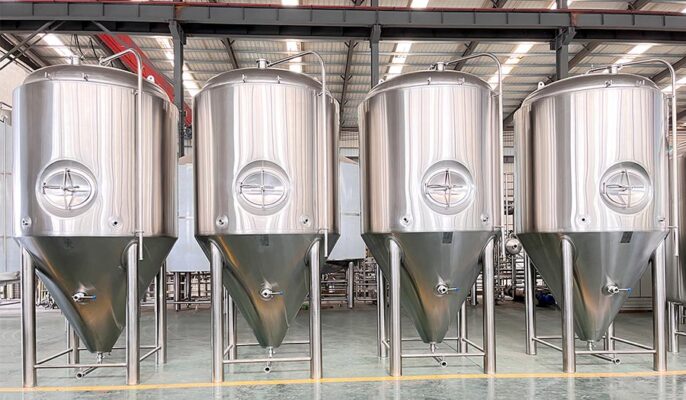Os fermentadores estão disponíveis em diversos tamanhos e formatos para atender às necessidades do cervejeiro. O tamanho é o principal fator a considerar na compra de um fermentador. Durante todo o processo de fermentação, também ao mosto, forma-se uma espessa camada de espuma, denominada espuma Clausen. Se o seu fermentador for muito pequeno, a espuma aumentará através da câmara de descompressão, obstruindo a câmara de descompressão e causando uma explosão. O fermentador deve ser pelo menos vinte por cento maior do que a quantidade de cerveja que você pretende preparar. Depois de determinar o tamanho do fermentador necessário, você poderá decidir sobre o estilo e o material mais adequados. Cada tipo de fermentador tem suas vantagens e desvantagens, mas sua decisão depende do orçamento e da preferência pessoal.
Tipos de fermentadores
Existem três tipos principais de tanques de fermentação, vamos dar uma olhada neles.
Tanque de fermentação de topo aberto
Os fermentadores de topo aberto são recipientes simples sem tampas ou vedantes e são o tipo mais básico de fermentador. São utilizados para fermentar vinho porque permitem um acesso fácil e a prensagem manual da tampa (a camada de peles e sementes de uva que sobem à superfície durante a fermentação).
Tanque de fermentação fechado
Os fermentadores fechados têm uma tampa selada que impede a entrada de quaisquer contaminantes externos no processo de fermentação. São utilizados no fabrico de cerveja porque protegem o líquido da exposição ao ar, que pode causar deterioração ou sabores estranhos.
Capacidade variável cuba de fermentação
Os fermentadores de capacidade variável têm tampas flutuantes e volumes ajustáveis, tornando-os adequados para fermentar diferentes quantidades de líquido. São populares entre os cervejeiros caseiros e os pequenos cervejeiros porque oferecem flexibilidade e ajudam a reduzir a quantidade de contacto do ar com o líquido em fermentação.

Qual é o tamanho do fermentador primário necessário?
Nas fases iniciais da fermentação, forma-se uma camada espessa de espuma no topo do mosto, chamada clausen. O Clausen ajuda a proteger o mosto em fermentação de infecções e é um bom indicador de como as coisas estão a correr. À medida que a fermentação termina, a quantidade de Clausen diminui.
Se encher um recipiente de fermentação com mosto, o Clausen não teria para onde ir e seria forçado a passar por uma câmara de ar que poderia estar entupida. A pressão no fermentador aumenta então até que a câmara de vácuo seja expelida.
Para evitar que isto aconteça, deve escolher um fermentador que seja 20% maior do que o volume de cerveja que pretende produzir. Isto deixa um espaço no topo do fermentador, chamado headspace.
A maior parte das receitas de cerveja caseira são concebidas para produzir lotes de cinco galões de cerveja e necessitam de um fermentador de seis galões ou de seis galões e meio.
Que tamanho de fermentador é necessário para a fermentação secundária?
Uma vez concluída a fermentação, pode engarrafar ou colocar a cerveja em barris, ou transferi-la para um segundo recipiente para envelhecimento. Por falar nisso, o fermentador secundário é um termo impróprio porque quase não ocorre fermentação. Nesta fase, também se pode adicionar mais lúpulo, especiarias e outros ingredientes.
Ao contrário dos fermentadores primários, os fermentadores primários devem ter mais espaço livre para a formação de Clausen. O fermentador secundário deve estar tão cheio quanto possível. Isto minimiza a quantidade de exposição ao ar e reduz a hipótese de oxidação e de sabores indesejados na cerveja.
Que tamanho de fermentador é necessário?
A cerveja pode ser engarrafada ou barrilada, ou pode ser transferida para um segundo recipiente para envelhecimento após a conclusão da fermentação. O segundo fermentador deve ser o mais completo possível. Isto reduz a quantidade de ar exposto e a hipótese de a cerveja oxidar e desenvolver sabores indesejáveis. Para o kit de 5 galões, necessitará de um fermentador secundário de 5 galões.
Seleção do material do tanque de fermentação
Baldes e bacias de plástico
Muitos produtores de cerveja caseira usam baldes de plástico de qualidade alimentar como tanques de fermentação. Os barris de plástico são baratos, leves, fáceis de armazenar e podem ser comprados com fechos de ar e espigões para engarrafar a cerveja acabada. transferir o mosto da panela para o fermentador. Barris de fermentação estão disponíveis em uma variedade de tamanhos, de 5 litros (1 galão) a 30 litros (8 galões). Ou pode comprar um recipiente de qualidade alimentar, adicionar uma câmara de vácuo e fazer uma torneira.
A desvantagem é que a tampa não é selada e o oxigénio pode entrar.

Garrafa de vidro
As garrafas de vidro são, desde há muito, a escolha ideal para a produção caseira de cerveja e vinho. Os jarros e frascos de vidro estão disponíveis numa gama mais ampla de tamanhos, desde frascos de meio galão (três litros) a frascos de 15 galões (54 litros). O vidro é resistente ao desgaste e não risca. É também 100% impermeável ao oxigénio e não absorve sabor ou odor.
Unlike buckets, small and large bottles are heavy and difficult to store because they cannot be stacked. They also usually don’t have taps, which means you have to use a siphon or rack rod to transfer your beer.
Tanque de fermentação em aço inoxidável
Stainless steel fermenters offer all the benefits of plastic fermenters but are scratch-proof, impermeable and very easy to clean. If you have the budget, Micet suppliers sell stainless steel fermentation tanks in various sizes. If you’ve ever visited a commercial brewery, you’ll notice that fermentation takes place in tall stainless steel vats that taper toward the bottom.
Os fermentadores cónicos permitem que as fábricas de cerveja removam as borras da cerveja sem a verterem para um segundo recipiente. Isto significa que as fermentações primária e secundária podem ter lugar no mesmo barril sem colocar a cerveja em risco de contaminação. Os fermentadores cónicos também facilitam a colheita da levedura, que pode depois ser limpa e reutilizada.
Como escolher o fermentador certo para as suas necessidades
Ao selecionar um tanque de fermentação, devem ser considerados os seguintes factores:
- O tipo de bebida ou alimento que pretende fermentar
- O seu nível de experiência e competências
- Espaço disponível na zona de fabrico de cerveja ou de fermentação
- O seu orçamento
- Capacidade necessária do fermentador





Eu amei ainda mais do que você vai conseguir aqui. A foto é bonita e sua escrita é estilosa, mas você parece estar com pressa e acho que deveria devolvê-la em breve. Provavelmente farei isso de novo e de novo se você proteger esta caminhada.